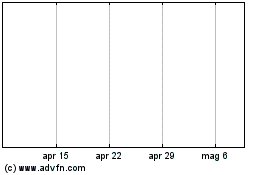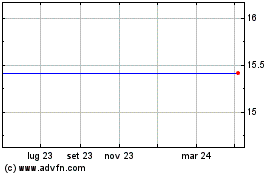By Nora Naughton and Mike Colias
The Covid-19 pandemic is changing an entrenched aspect of car
shopping in America: finding your new ride on the lot and driving
it home that day.
For months, dealer stocks have been running about 25% thinner
than normal, a hangover effect from two months of pandemic-related
factory closures last spring. The shortfall is requiring many
buyers to order their cars and wait a few weeks, running counter to
the American car shopper's desire for instant gratification, and
dealers' impulse to send the customer home in a new car that
day.
That change may outlast the pandemic as industry executives find
that stocking fewer cars, amid high demand, has lifted profits for
car companies and dealers alike. Now both are talking about
carrying fewer vehicles on the dealership lot permanently, in what
would mark a monumental shift in the way cars are sold in the
U.S.
For decades, American car dealerships have kept endless rows of
vehicles outside their stores in enough colors and variations for
buyers to find what they want, when they want it. Reducing that
mass of sheet metal would result in more customers preordering
their cars weeks in advance, a practice common in Europe and
elsewhere. The change could have implications for dealer-owned real
estate and how car companies run their factories.
The benefits of leaner dealership lots have been an unexpected
byproduct of the pandemic. Auto makers have been straining to boost
output after the spring shutdowns, a task made difficult by an
unexpected surge in demand for new vehicles. The result has been a
seller's market, with car companies able to hold the line on
discounts, driving prices to record highs.
And, because of the inventory crunch, car companies have been
giving priority to their most popular models and feature
combinations, which has reduced complexity and cut supply-chain
costs, the companies say.
Meanwhile, dealers are saving money by holding less inventory,
and cars are selling faster, at higher average prices. The typical
new vehicle spent about 56 days on a dealer lot in October, down
27% from the same month last year, according to car-shopping
website Edmunds.com.
A shift to online shopping has been a factor, too. With fewer
prospective buyers visiting showrooms during the pandemic, dealers
say they don't need as many cars on the lot for test drives. There
were nearly a million fewer cars at all U.S. dealers at the end of
October, or 25% fewer compared with a year earlier, according to
research firm Motor Intelligence.
"We're spending a lot of time trying to understand this and
saying 'Hey, is there a better distribution model?' " General
Motors Co. U.S. sales chief Steve Hill said. "You never want to let
a good crisis go to waste."
GM's dealers have been working with just one-third of their
typical level of inventory in pickup trucks, the biggest moneymaker
for the company and dealers. Even so, GM has gained market share in
that lucrative category recently, a sign that dealers and customers
are adapting, he said.
Georgia dealer Mike Bowsher, who owns four GM stores across the
Southeast, said his profit per vehicle is up sharply because of
lower discounting. And he is spending less money on inventory
because about half his customers have been prepurchasing cars
before they hit his lot. In normal times, nearly all his customers
buy straight from his on-hand selection.
Mr. Bowsher said he has implored GM's sales chief to continue to
run lean.
"I told Steve, 'You guys just had a monster quarter. The
customers are happy, dealers are making money,' " Mr. Bowsher said.
"We've got to keep this train rolling."
GM, Ford Motor Co. and Fiat Chrysler Automobiles NV each
credited strong pricing and lower costs for their solid
third-quarter results, with profit margins in North America soaring
to record or near-record levels.
"I don't think our dealers want to go back to historic inventory
levels, " Fiat Chrysler Chief Executive Mike Manley told investors
last month. "What I think we see now is somewhat closer to the new
normal of inventory levels."
Auto-industry analysts, dealers and executives likened the new
approach to dealer inventories in the U.S. to that of Europe, where
customers have for years ordered from the factory rather than
picking from a pool of cars at a dealership.
Still, such a shift for American consumers could be a harder
sell in the long run, dealers say. Car makers for years have tried
to thin dealer stocks and simplify their model offerings, but have
historically failed as brands compete for customers.
"I can only assume that the supply will creep back up," said
David Hult, CEO of Asbury Automotive Group, a publicly traded
dealership chain based in Georgia. "Brand loyalty isn't what it
used to be, and when someone else has a product available that you
don't, you could actually lose sales."
Mr. Hill said he believes GM will continue to run on lower
dealer stocks long-term, but he doesn't think that means
significantly more customers will be preordering cars. He said GM
has started using more-precise analytics to fine-tune dealers'
inventory so that customers can find what they want on the lot or
online.
Andrew Coles scoured dealerships in his area for a new Chevrolet
Tahoe recently but couldn't locate the exact model he wanted.
Eventually, a dealer found Mr. Cole's preferred model en route from
the factory -- he just had to wait six weeks for it to arrive.
The 34-year-old Larchmont, N.Y., resident said he grew impatient
but in the end was happy to get the vehicle he wanted at the right
price.
"It's not like we needed it that day," he said.
Write to Mike Colias at Mike.Colias@wsj.com
(END) Dow Jones Newswires
November 22, 2020 13:14 ET (18:14 GMT)
Copyright (c) 2020 Dow Jones & Company, Inc.
Grafico Azioni Stellantis NV (BIT:STLA)
Storico
Da Mar 2024 a Apr 2024

Grafico Azioni Stellantis NV (BIT:STLA)
Storico
Da Apr 2023 a Apr 2024
